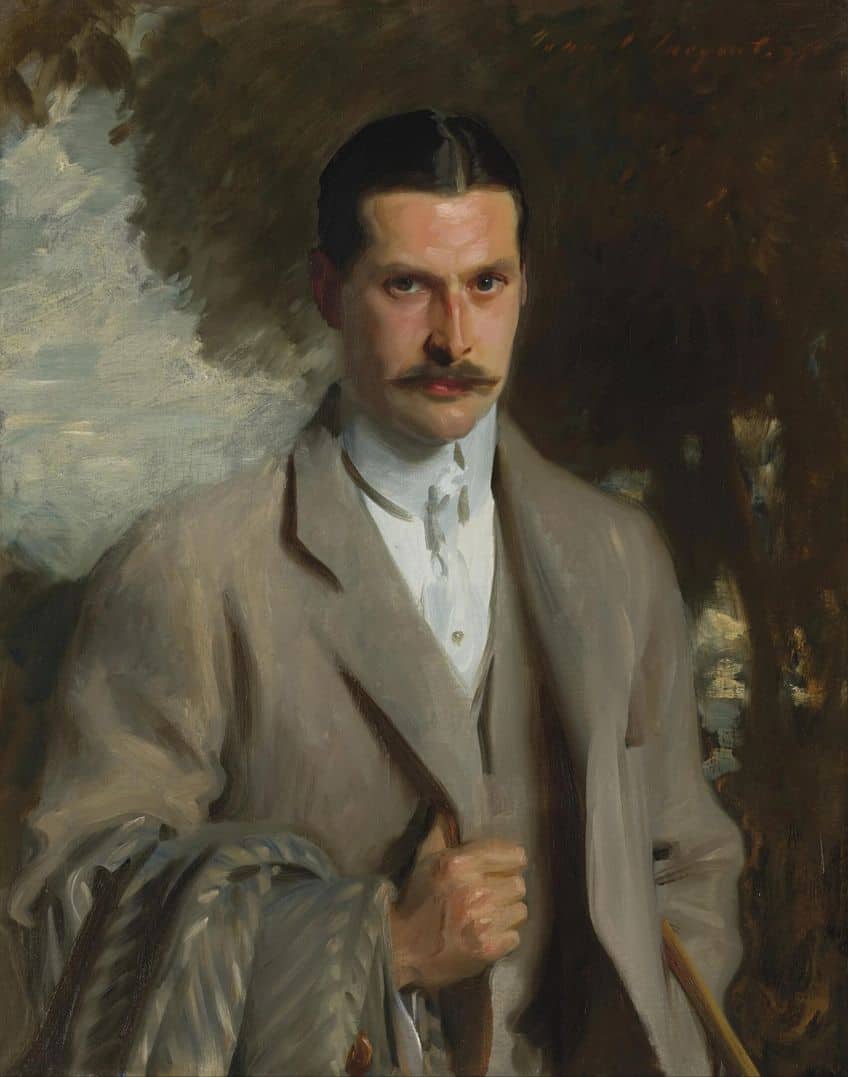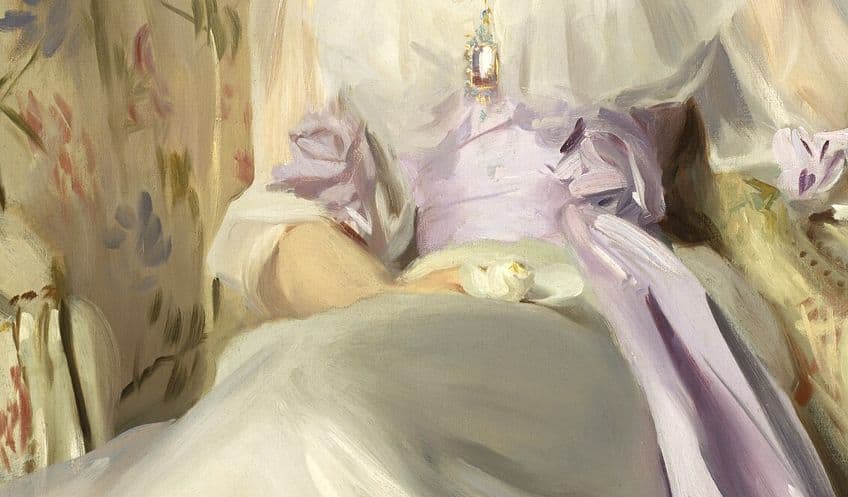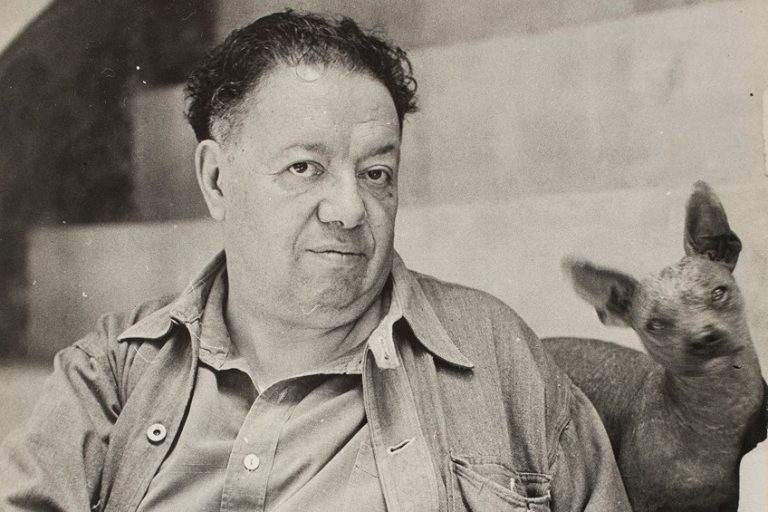“Lady Agnew of Lochnaw” by John Singer Sargent – An Analysis
John Singer Sargent’s portrait of Lady Agnew of Lochnaw stands as a testament to the artist’s mastery in capturing the essence of his subjects. Painted in 1892, the oil on canvas work depicts Gertrude Agnew, the wife of Sir Andrew Agnew, 9th Baronet. Sargent’s skillful application of paint and his ability to evoke personality and presence through portraiture are exemplified in this piece. Below, we will be taking a closer look at the artistic elements in the work, as well as the painting’s influence.
Table of Contents
Key Takeaways
- Lady Agnew of Lochnaw is a significant portrait by John Singer Sargent that showcases his exceptional skill in oil on canvas.
- The work is notable for its departure from traditional portraiture, particularly through the confident demeanor and direct gaze of the sitter.
- Upon its public display, the painting quickly achieved critical success, solidifying Sargent’s reputation in the world of fine art.
The Portrait of Lady Agnew
| Artist | John Singer Sargent (1856 – 1925) |
| Date Created | 1892 |
| Medium | Oil on canvas |
| Genre | Portrait |
| Period/Movement | Late 19th to early 20th-century American Realism |
| Dimensions (cm) | 125.7 cm × 99.7 cm (49.5 in × 39.3 in) |
| Series/Versions | N/A |
| Where Is It Housed? | Scottish National Gallery, Edinburgh, Scotland |
| What It Is Worth | Valued at an estimated £20 million (as of 2022) |
This section dissects Lady Agnew of Lochnaw, John Singer Sargent’s celebrated portrait, exploring its historical significance and the identity of its subject.

Historical Context
In 1892, John Singer Sargent, an American painter noted for his portraits, was commissioned to paint Lady Agnew of Lochnaw. The portrait is a striking representation of Gertrude Agnew, the wife of Sir Andrew Noel Agnew, 9th Baronet, exemplifying Sargent’s mastery in capturing the essence of Edwardian society’s high-profile figures. Upon its reveal at the Royal Academy of Arts’ Summer Exhibition in London, the piece garnered immediate acclaim, subsequently cementing Sargent’s status as a premier portraitist of his time.

Who Was Lady Agnew?
Lady Agnew of Lochnaw, commonly known as Gertrude Agnew, was a prominent figure within Scotland’s high society. Her poise and expression in the portrait suggest a personality both distinct and engaging, capturing the viewer’s attention. The painting shows Lady Agnew seated in a three-quarter length pose, dressed in a flowing white gown with a silk mauve sash—elements that emphasize her femininity and modern elegance of the time. The portrait’s existence as a renowned artwork is as much about Lady Agnew’s compelling countenance as it is about Sargent’s technique—vividly rendered through the oil on canvas medium that brings to life the textures of Chinese silk, the softness of the dress, and the luminosity of her skin.
Today, Lady Agnew of Lochnaw is housed in the Scottish National Gallery in Edinburgh, treasured as part of Scotland’s national art collection.
Artistic Elements
In exploring the Lady Agnew of Lochnaw by John Singer Sargent, the artistic elements of subject matter, color, and texture are paramount in appreciating this oil on canvas portrait.
Subject Matter
The Lady Agnew of Lochnaw is a portrait painting of Gertrude Agnew, wife of Sir Andrew Agnew. The subject sits in an upholstered chair, her posture relaxed yet confident, exuding femininity and poise. This artwork signals a shift towards more modern portrait compositions in the late 19th century.
It is departing from the rigid formality of earlier periods.

Color
Sargent employs a palette that highlights the softness of Lady Agnew’s white gown against a muted background. The color scheme is notable for its harmonious blend of whites, creams, and the subtle hues of the silk mauve sash around her waist.
The use of color enhances the overall composition and brings focus to the subject’s serene expression and the elegant fabrics.

Texture
Texture plays a critical role in this portrait as Sargent showcases his mastery of technique through the realistic depiction of various materials. The painter captures the sheen of the silk fabric of the sash, the intricate lace of the gown, and the softness of the skin with meticulous brushwork.
These textural details enrich the tactile quality of the painting, engaging the viewer with the sensation of the subject’s attire and setting.

Influence of the Artwork
Lady Agnew of Lochnaw, painted by John Singer Sargent, gained notoriety for its striking portrayal and influence on the artist’s reputation, ultimately bolstering his status within the art community.
John Singer Sargent’s portrait of Lady Agnew of Lochnaw left a significant mark on the art world through its compelling style and the portrayal of its subject.
Cultural Impact & Legacy
Upon its exhibition at the Royal Academy in London in 1893, the painting was highly acclaimed, which considerably enhanced Sargent’s profile. This event coincided with Sargent’s acceptance as an associate of the Academy the following January, reflecting the work’s immediate impact on his career. In broader cultural terms, Lady Agnew’s depiction has been celebrated for its modern approach to Victorian portraiture. The artwork’s legacy persists, as it continues to be featured in art historical discussions and exhibitions.

To this day, it resides in the Scottish National Gallery in Edinburgh, attracting visitors and art enthusiasts, contributing to the understanding of Sargent’s oeuvre and the era’s portraiture style. The painting’s prominence has also ingrained Lady Agnew as an iconic figure within the canon of Western art history.
John Singer Sargent’s Lady Agnew of Lochnaw is a definitive work of his portraiture prowess. The painting broke conventions of the time with Lady Agnew’s direct and confident gaze, a departure from the demure expressions typical in portraiture of that era. Upon its exhibition at the Royal Academy in London in 1893, the painting garnered immediate acclaim, cementing Sargent’s status as a leading portrait artist of his time. The work is an immortal testament to Sargent’s talent and a piece that endures in its ability to engage admirers, both for its historical context and its aesthetic merit.
Frequently Asked Questions
What Is the Historical Significance of the Portrait?
This painting by John Singer Sargent, completed in 1892, showcases the artist’s skill in portraiture and is significant for its representation of Edwardian-era high society. The confident gaze and relaxed posture of Lady Agnew was a departure from the more rigid portraiture of the time, reflecting Sargent’s innovative approach to capturing character and elegance.
Who Was Gertrude Agnew?
Gertrude Agnew, born Gertrude Vernon in 1864, became Lady Agnew upon marrying Sir Andrew Noel Agnew, a Scottish baronet. She gained prominence through this masterful portrait by John Singer Sargent, which contributed to her social standing and is celebrated for its portrayal of her natural grace and presence.
Isabella studied at the University of Cape Town in South Africa and graduated with a Bachelor of Arts majoring in English Literature & Language and Psychology. Throughout her undergraduate years, she took Art History as an additional subject and absolutely loved it. Building on from her art history knowledge that began in high school, art has always been a particular area of fascination for her. From learning about artworks previously unknown to her, or sharpening her existing understanding of specific works, the ability to continue learning within this interesting sphere excites her greatly.
Her focal points of interest in art history encompass profiling specific artists and art movements, as it is these areas where she is able to really dig deep into the rich narrative of the art world. Additionally, she particularly enjoys exploring the different artistic styles of the 20th century, as well as the important impact that female artists have had on the development of art history.
Learn more about Isabella Meyer and the Art in Context Team.
Cite this Article
Isabella, Meyer, ““Lady Agnew of Lochnaw” by John Singer Sargent – An Analysis.” Art in Context. January 30, 2024. URL: https://artincontext.org/lady-agnew-of-lochnaw-by-john-singer-sargent/
Meyer, I. (2024, 30 January). “Lady Agnew of Lochnaw” by John Singer Sargent – An Analysis. Art in Context. https://artincontext.org/lady-agnew-of-lochnaw-by-john-singer-sargent/
Meyer, Isabella. ““Lady Agnew of Lochnaw” by John Singer Sargent – An Analysis.” Art in Context, January 30, 2024. https://artincontext.org/lady-agnew-of-lochnaw-by-john-singer-sargent/.











